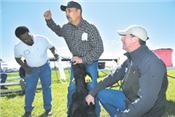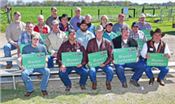|
Calf Care Highlights Cattle Field Day

Stan Dutile, LSU AgCenter county agent, at center, demonstrates the feeding of
colostrum to a newborn calf. Assisting is Andrew Granger, LSU AgCenter county
agent, at right, as Lawrence Christy holds the feeding bag. The
demonstration was conducted during the Acadiana Cattle Producers
and Iberia Research Station field day.
Photo by Bruce Schultz/LSU AgCenter
JEANERETTE, LA.
Getting colostrum into a newborn calf is critical for it to survive, and feeding must be induced if the calf refuses to nurse, LSU AgCenter agents said at a demonstration during the Acadiana Cattle Producers and Iberia Research Station field day.
Andrew Granger, AgCenter agent in Vermilion Parish, said the time window is small for a calf to get the colostrum, the first milk from a mother following birth, which is rich in antibiotics and nutrients.
Two to four hours after birth is the time for the most complete absorption of antibodies by the calf.
“The quicker the better. The gut starts to close off shortly after they are born,” Granger said.
After a difficult birth, a calf is weaker and it’s even more critical that it receives colostrum quickly.
Powdered colostrum can be mixed using a whisk in warm water to be fed to a calf using a feeding tube that is inserted in the calf’s throat, said AgCenter agent Stan Dutile.
Granger and Dutile also covered the process of delivering a calf.
A calf that is positioned backwards must be pulled from the birth canal quickly because the newborn is often unable to get oxygen, Granger said.
Kurt Guidry, director of the LSU AgCenter Southwest Region, said a reorganization of AgCenter agents is underway because of budget constraints.
Agents will specialize in a commodity and will be assigned to multiple parishes. “We’re still going to have someone domiciled in just about every parish,” Guidry said.
Kathleen Bridges, an LSU doctoral student, and AgCenter ruminant nutritionist Guillermo Scaglia talked about cover crops in pastures.
Cover crops can increase forage productivity because of an increase in microbial organisms that produce enzymes that help plants grow, Bridges said.
Scaglia gave details on a test using brassica plants, including kale, radishes and turnips, planted in early fall with oats, ryegrass and clovers. Cattle preferred radishes, and average daily weight gains for cull cows and 600-pound steers were good and less expensive than feeding hay and supplements.
Scaglia also talked about his demonstration project of two 30-cow herds that compares a low-input cow-calf system versus a high-input plan. Differences between them include a lower stocking rate and less money spent on fertilizer, minerals and supplements in the low-input system.
In the high-input system, weeds were sprayed with herbicides to control them as needed.
Average results over four years showed that the return above expenses in the low-input system was $109 per cow, compared with $151 in the high-input system.
A survey done by Beef magazine showed that two-thirds of producers said input costs have the biggest effect on profitability, Scaglia said.
“One way to deal with costs is to intensify production and hence produce more; however, you must plan for a change like this, making sure you have the resources and time to give it a try,” he said.
Colin Woodall, senior vice president for government affairs of the National Cattlemen’s Beef Association, said Japan is the No. 1 buyer of American beef, despite a 38 percent tariff. Korea and China are the second and third largest markets, he said.
A renegotiation of NAFTA should maintain access to international markets, Woodall said.
But beef could be adversely affected by the Trump administration’s proposed tariffs on steel and aluminum that would prompt other countries to retaliate by raising tariffs on U.S. agricultural products. “There is a high likelihood,” he said.
AgCenter veterinarian Dr. Jacques Fuselier said fecal sampling will reveal the effectiveness of a deworming program.
“All cattle need to be dewormed,” Fuselier said. “Having control of this [internal parasites] is critical for the rest of your operation.”
Parasites become resistant to dewormers, but producers can defend against resistance by using products with different modes of action, he said.
Jeff Gurie, an AgCenter research associate at the Dean Lee Research Station, said a test of the ESN nitrogen product in ryegrass allowed grazing 10 days earlier than plots that received urea treated with Agrotain or urea only.
Regrowth was sufficient to allow grazing again in 20 days, he said.
The product has a polymer coating that allows the nitrogen to be released gradually, he said.
Also at the field day, 38 graduates of the Louisiana Master Cattleman program were recognized. A new Master Cattleman class will be held in fall 2019 for the Acadiana area. ∆

Recent graduates of the Louisiana Master Cattleman program were recognized during the Acadiana Cattle Producers and Iberia Research Station field day on March 3. From left to right, front row, are Tyler Credeur, of Lafayette Parish; Allen Bourgeois, of St. Martin Parish; Darryl Bouillion, of Vermilion Parish; Benjamin Boudreaux, of Lafayette Parish; and Frank Bacque, of Vermilion Parish. Second row, from left, are Blake Huggard, of St. Landry Parish; Glynn Hebert, of Vermilion Parish; Colby Gothreaux, of Acadia Parish; Sage Edelkind, of St. Landry Parish; and Harlan Denais, of Lafayette Parish. Back row, from left, are Chris Thibodeaux, of Jefferson Davis Parish; Thomas Richard, of Lafayette Parish; Dale Reed, of Evangeline Parish; Ted Miller and Emily Miller, both of St. Landry Parish; Todd Miguez, of Vermilion Parish, and Timothy McGee, of Acadia Parish.
Photo by Bruce Schultz/LSU AgCenter
|
|